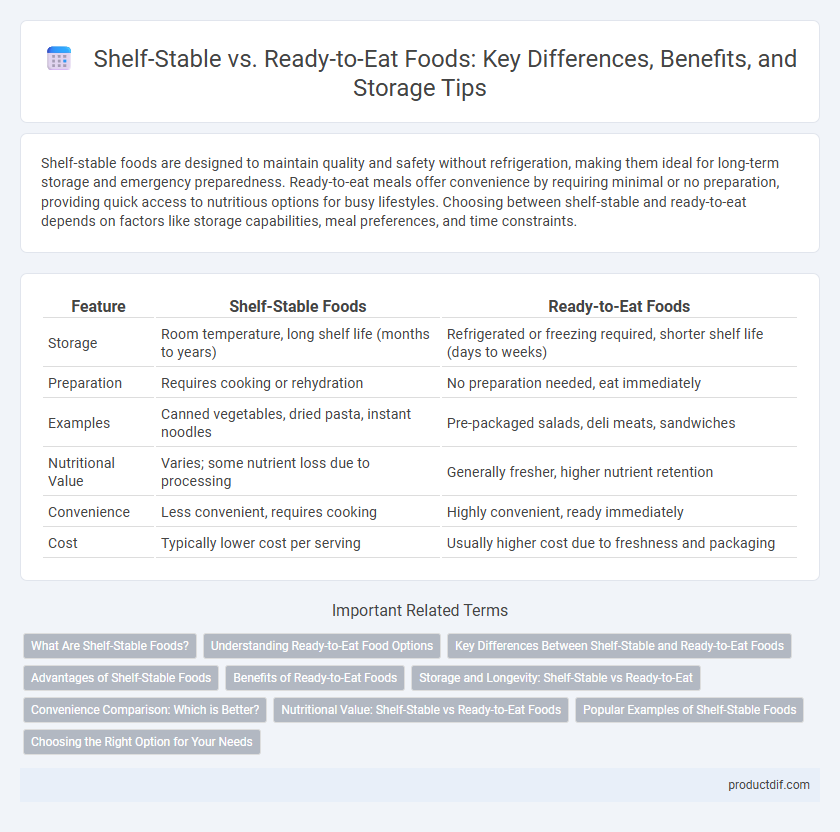Shelf-stable foods are designed to maintain quality and safety without refrigeration, making them ideal for long-term storage and emergency preparedness. Ready-to-eat meals offer convenience by requiring minimal or no preparation, providing quick access to nutritious options for busy lifestyles. Choosing between shelf-stable and ready-to-eat depends on factors like storage capabilities, meal preferences, and time constraints.
Table of Comparison
| Feature | Shelf-Stable Foods | Ready-to-Eat Foods |
|---|---|---|
| Storage | Room temperature, long shelf life (months to years) | Refrigerated or freezing required, shorter shelf life (days to weeks) |
| Preparation | Requires cooking or rehydration | No preparation needed, eat immediately |
| Examples | Canned vegetables, dried pasta, instant noodles | Pre-packaged salads, deli meats, sandwiches |
| Nutritional Value | Varies; some nutrient loss due to processing | Generally fresher, higher nutrient retention |
| Convenience | Less convenient, requires cooking | Highly convenient, ready immediately |
| Cost | Typically lower cost per serving | Usually higher cost due to freshness and packaging |
What Are Shelf-Stable Foods?
Shelf-stable foods are products that maintain their safety, texture, and nutritional value without refrigeration, often preserved through canning, drying, or vacuum sealing. These foods include items like canned vegetables, dried grains, and sealed snacks, designed for long-term storage and convenience. Their extended shelf life reduces food waste and provides reliable nutrition during emergencies or situations with limited access to fresh foods.
Understanding Ready-to-Eat Food Options
Ready-to-eat food options offer convenience by requiring no additional preparation or cooking, making them ideal for quick meals and on-the-go consumption. These products often include items like canned soups, packaged sandwiches, and pre-cooked meals that maintain safety and flavor without refrigeration. Understanding shelf-stable versus ready-to-eat foods helps consumers make informed choices based on storage capabilities and nutritional needs.
Key Differences Between Shelf-Stable and Ready-to-Eat Foods
Shelf-stable foods are designed to remain safe and unspoiled at room temperature for extended periods, using methods like dehydration, canning, or vacuum sealing, whereas ready-to-eat foods require minimal or no preparation before consumption. Key differences include packaging technology, preservation techniques, and intended usage, with shelf-stable items prioritizing longevity and storage convenience while ready-to-eat products emphasize immediate consumption and freshness. Nutritional content and flavor profiles may also vary, as shelf-stable foods often undergo processing that can affect taste and nutrient retention compared to freshly prepared ready-to-eat options.
Advantages of Shelf-Stable Foods
Shelf-stable foods offer extended shelf life without refrigeration, reducing food waste and ensuring availability during emergencies or in remote areas. These products retain nutritional value and flavor through advanced preservation techniques like dehydration, canning, or vacuum sealing. Their convenience supports efficient meal planning and storage, especially for households with limited space or irregular shopping schedules.
Benefits of Ready-to-Eat Foods
Ready-to-eat foods offer unparalleled convenience by eliminating preparation and cooking time, making them ideal for busy lifestyles and quick meals. These foods often come in portion-controlled packages, enhancing freshness and reducing food waste. Their accessibility and ease of consumption contribute significantly to improved time management and nutrition for individuals on the go.
Storage and Longevity: Shelf-Stable vs Ready-to-Eat
Shelf-stable foods are designed for extended storage without refrigeration, maintaining safety and quality through methods like dehydration, canning, or vacuum sealing. Ready-to-eat foods prioritize convenience, offering immediate consumption but often require refrigeration and have shorter shelf lives. Understanding the storage requirements and longevity differences helps optimize food safety and reduce waste in various consumption contexts.
Convenience Comparison: Which is Better?
Shelf-stable foods offer long-term storage without refrigeration, providing convenience for meal planning and emergency preparedness. Ready-to-eat options eliminate cooking time, making them ideal for quick meals and on-the-go consumption. The better choice depends on individual lifestyle needs, with shelf-stable items excelling in durability and ready-to-eat foods in immediate accessibility.
Nutritional Value: Shelf-Stable vs Ready-to-Eat Foods
Shelf-stable foods often maintain their nutritional value through preservation methods like dehydration or canning, preserving essential vitamins and minerals for extended periods. Ready-to-eat foods prioritize convenience but can sometimes have reduced nutrient levels due to cooking or processing techniques. Comparing nutritional content, shelf-stable options may offer higher retention of key nutrients, while ready-to-eat meals provide immediate consumption with varied nutrient profiles.
Popular Examples of Shelf-Stable Foods
Shelf-stable foods such as canned beans, dried pasta, and powdered milk maintain quality without refrigeration, making them essential for long-term storage and emergency preparedness. Popular examples also include vacuum-sealed nuts, shelf-stable sauces like soy sauce, and freeze-dried fruits, which offer convenience and extended shelf life. These foods provide reliable nutrition and flavor while reducing waste through improved durability and packaging technology.
Choosing the Right Option for Your Needs
Shelf-stable foods offer long-lasting storage without refrigeration, ideal for emergency preparedness and limited kitchen space, while ready-to-eat options provide immediate convenience and minimal preparation time, perfect for busy lifestyles. Understanding product labels, such as expiration dates and storage requirements, helps ensure safety and nutritional value align with your consumption habits. Selecting between shelf-stable and ready-to-eat depends on factors like meal frequency, storage capability, and desired freshness to best meet your dietary needs.
Shelf-Stable vs Ready-to-Eat Infographic

 productdif.com
productdif.com